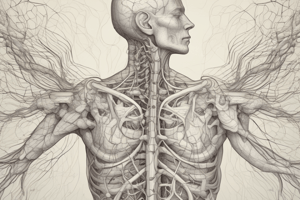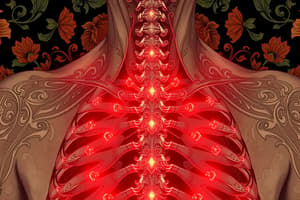Podcast
Questions and Answers
What can cause a vertebral fracture?
What can cause a vertebral fracture?
- Hyperflexion (correct)
- High-impact athletic activities
- Prolonged sitting
- Low calcium diet
What is a common symptom of Scheuermann Disease?
What is a common symptom of Scheuermann Disease?
- Frequent headaches
- Loss of appetite
- Kyphosis (correct)
- Tingling in the hands
Which of the following best describes the type of injury associated with rib fractures?
Which of the following best describes the type of injury associated with rib fractures?
- Traction injuries
- Trauma from a seatbelt during an accident (correct)
- Injury from repetitive strain
- Direct superficial trauma
Which symptom is associated with T4 Syndrome?
Which symptom is associated with T4 Syndrome?
What is the relationship between scapular fractures and neural damage?
What is the relationship between scapular fractures and neural damage?
What triggers the sympathetic response in T4 Syndrome?
What triggers the sympathetic response in T4 Syndrome?
During which life stage is Scheuermann Disease most commonly diagnosed?
During which life stage is Scheuermann Disease most commonly diagnosed?
What is a common mechanical cause of vertebral fractures classified as wedge or compression fractures?
What is a common mechanical cause of vertebral fractures classified as wedge or compression fractures?
What is the common direction for lumbar disc pathology?
What is the common direction for lumbar disc pathology?
What is a common symptom associated with facet dysfunction?
What is a common symptom associated with facet dysfunction?
Which levels are most commonly affected by lumbar radiculopathy?
Which levels are most commonly affected by lumbar radiculopathy?
At what age group is lumbar stenosis most commonly seen?
At what age group is lumbar stenosis most commonly seen?
What condition describes the anterior slippage of vertebrae?
What condition describes the anterior slippage of vertebrae?
What symptom may be present with spondylolisthesis?
What symptom may be present with spondylolisthesis?
Which condition is associated with 'shopping cart syndrome'?
Which condition is associated with 'shopping cart syndrome'?
Which activity is preferred over standing for individuals with lumbar issues?
Which activity is preferred over standing for individuals with lumbar issues?
What is a characteristic of spondylosis?
What is a characteristic of spondylosis?
Which segment of the spine is most impacted by repetitive stress into flexion?
Which segment of the spine is most impacted by repetitive stress into flexion?
What typically represents the location affected by spondylosis?
What typically represents the location affected by spondylosis?
Which of the following is NOT a component of lumbar disc pathology?
Which of the following is NOT a component of lumbar disc pathology?
Hypermobile lumbar segments are most likely associated with which condition?
Hypermobile lumbar segments are most likely associated with which condition?
What is a common complain associated with lumbar disc pathology?
What is a common complain associated with lumbar disc pathology?
What symptom is commonly associated with lumbar stenosis when standing?
What symptom is commonly associated with lumbar stenosis when standing?
Which condition refers to a fracture to the pars interarticularis?
Which condition refers to a fracture to the pars interarticularis?
Which anatomical areas are associated with T1 and T2 thoracic disc pain?
Which anatomical areas are associated with T1 and T2 thoracic disc pain?
What is a primary characteristic of thoracic zygapophyseal pain?
What is a primary characteristic of thoracic zygapophyseal pain?
What type of dysfunction is indicated by hypomobility in the thoracic region?
What type of dysfunction is indicated by hypomobility in the thoracic region?
Which sign is associated with sacroiliac joint dysfunction?
Which sign is associated with sacroiliac joint dysfunction?
Which of the following symptoms is most likely associated with rib dysfunction?
Which of the following symptoms is most likely associated with rib dysfunction?
Which thoracic region is associated with pain in the unilateral buttock?
Which thoracic region is associated with pain in the unilateral buttock?
What is the typical cause of thoracic disc pain?
What is the typical cause of thoracic disc pain?
Which assessment technique is NOT typically related to sacroiliac joint dysfunction?
Which assessment technique is NOT typically related to sacroiliac joint dysfunction?
What condition is associated with pain during rotation due to a rib being stuck?
What condition is associated with pain during rotation due to a rib being stuck?
Which type of glide is applied with inhalation for first rib dysfunction?
Which type of glide is applied with inhalation for first rib dysfunction?
What is a key characteristic of musculoskeletal subluxation?
What is a key characteristic of musculoskeletal subluxation?
Which of the following best describes Tietze syndrome?
Which of the following best describes Tietze syndrome?
What might a patient experience if they have a posterior restriction of the first rib?
What might a patient experience if they have a posterior restriction of the first rib?
What condition primarily results from recent trauma or repetitive use affecting a muscle?
What condition primarily results from recent trauma or repetitive use affecting a muscle?
What symptom is often aggravated by deep breathing in cases of Tietze syndrome?
What symptom is often aggravated by deep breathing in cases of Tietze syndrome?
Which term describes the hypomobile condition of the first rib during exhalation when it is restricted anteriorly?
Which term describes the hypomobile condition of the first rib during exhalation when it is restricted anteriorly?
Flashcards are hidden until you start studying
Study Notes
Thoracic Differential Diagnoses
- Thoracic Disc Pain: Commonly caused by degenerative changes. Pain location varies depending on the affected level:
- T1-T2: Hand, arm, medial forearm
- T2-T3: Clavicle, scapular spine, medial upper arm
- T3-T8: Side/front of trunk, often unilateral and beyond the affected segment
- T9-T11: Unilateral buttock pain, bilateral at the conus medullaris.
- Thoracic Zygapophyseal (Facet) Pain: Characterized by hypomobility, pain with movement, and reduced thoracic extension.
- Rib Dysfunction: Pain often worsens with deep breathing, coughing, sneezing, and rotation. Three types:
- Subluxation: Caused by trauma.
- Torsional: Rib stuck in external or internal rotation.
- Respiratory: Associated with poor posture.
- First Rib Dysfunction: Movement differs during inhalation and exhalation:
- Inhalation: Anterior, inferior, medial glide.
- Exhalation: Posterior, superior, lateral glide.
- Subluxation presents with a sudden hard end-feel. Periscapular involvement shows restriction in one direction; myofascial involvement shows normal movement.
- Anterior restriction: Hypomobile superiorly, ipsilateral side, during exhalation
- Posterior restriction: Hypomobile inferiorly, contralateral side, during inhalation.
- Tietze Syndrome: Localized inflammation of costosternal cartilage, aggravated by deep breathing. Pain may radiate to the upper extremity.
- Thoracic Muscle Strain: Due to recent trauma or repetitive use, presenting with local pain and tenderness.
- Thoracic Contusions: Result from recent trauma, often seen after motor vehicle accidents (seatbelt injuries).
- Thoracic Fractures:
- Rib fractures: Result from trauma.
- Scapular fractures: Rare, often involving neural damage.
- Vertebral fractures:
- Wedge/compression fractures: Caused by hyperextension.
- Burst fractures: Caused by axial loading, common at T9-T11, often associated with osteoporosis or Scheuermann's disease.
- Sternal fractures: Rare, frequently caused by seatbelt injuries.
- Scheuermann's Disease: Occurs in adolescence, involving a defect in the apophysis leading to anterior wedging of vertebrae. Presents with kyphosis and pain with thoracic extension and rotation.
- T4 Syndrome: A sympathetic response to hypomobility, presenting with "stocking-glove" paresthesia, neck pain, headaches—symptoms worse in sitting/standing positions. Often accompanied by positive slump and upper limb tension tests.
Lumbar and Sacroiliac (SIJ) Differential Diagnoses
- Sacroiliac (SIJ) Dysfunction: May be related to pregnancy. Fortin's sign may be present. Treatment may involve thigh thrust, distraction, compression, and sacral thrust maneuvers. Plantarflexors/posterior leg muscles may be involved (S1).
- Lumbar Facet Dysfunction: Common in those aged 30-40. Characterized by "tightness" around the back, hypomobility, unilateral low back pain (LBP), and pain from prolonged positioning. May present with hypermobile lumbar segments or opening/closing restrictions.
- Lumbar Spinal Stenosis: Most common in individuals over 60. Presents with bilateral symptoms, pain exacerbated by extension (repetitive stress in extension), and "shopping cart" syndrome (pain relief when leaning forward). Sitting is usually preferred over standing, and walking/standing is painful.
- Lumbar Spondylosis: A degenerative condition, often providing pain relief with rest. Most commonly affects L5-S1.
- Spondylolysis: Fracture at the pars interarticularis, often caused by repetitive extension or hyperextension with rotation. Sitting is preferred over standing.
- Spondylolisthesis: Anterior slippage of one vertebra over another, most commonly at L5-S1 or L4-L5. Neurogenic claudication might be present.
- Lumbar Disc Pathology: Most frequently affects L4-L5 and L5-S1, most commonly in a posterolateral direction. Presents unilaterally, often due to repetitive flexion or heavy compressive loads. May manifest as a protrusion, prolapse, extrusion, or sequestration.
- Lumbar Radiculopathy: Often involves L4-L5-S1 nerve roots.
- L4: Affects quadriceps and anterolateral thigh.
- L5: Affects extensor hallucis longus and lateral thigh.
Studying That Suits You
Use AI to generate personalized quizzes and flashcards to suit your learning preferences.




